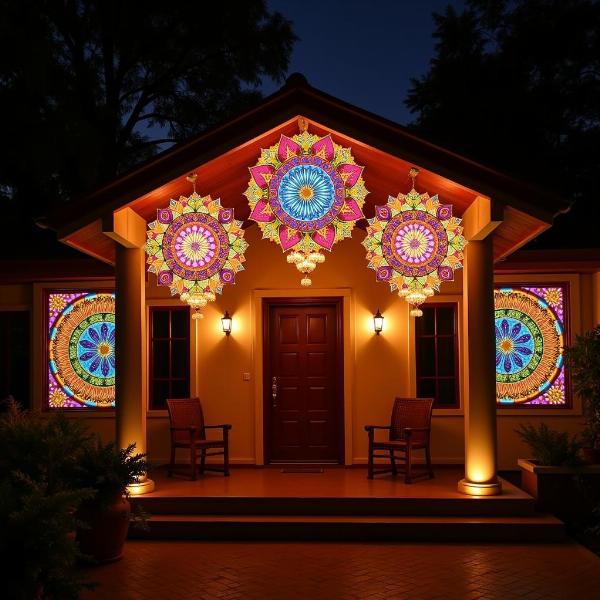Sanjhi, a mesmerizing art form deeply rooted in Indian culture, holds a special significance, particularly in the Braj region of Uttar Pradesh. Understanding the “sanjhi meaning in hindi” opens a window into a rich tradition blending artistry, spirituality, and storytelling. This article delves into the multifaceted meanings of sanjhi, exploring its historical context, religious symbolism, and contemporary relevance.
Exploring the Word “Sanjhi”
The word “sanjhi” itself offers clues to its meaning. Derived from the Sanskrit “sanjha,” it signifies “shared,” “common,” or “joint.” This shared aspect relates both to the communal nature of its creation and the collective appreciation of the finished artwork. Sanjhi also refers to the evening time, the period when these intricate paper stencils are traditionally displayed and illuminated. This connection adds another layer of meaning, associating sanjhi with the sacred twilight hours.
Sanjhi: A Blend of Art and Devotion
Sanjhi is more than just paper cutting; it’s a devotional practice intricately woven into the worship of Krishna. The intricate designs often depict scenes from Krishna’s life, particularly his leela (divine play) with Radha and the gopis (milkmaids). This artistic expression serves as a visual narrative of these sacred stories, making them accessible and tangible for devotees.
The Symbolism in Sanjhi Designs
Each element within a sanjhi design carries symbolic weight. The lotus flower represents purity and divine beauty, while peacocks symbolize love and devotion. The intricate patterns and interwoven motifs reflect the complex interplay of the divine and the earthly, the spiritual and the material.
Sanjhi: A Living Tradition
While traditionally practiced by women during festivals like Diwali and Janmashtami, sanjhi continues to evolve. Contemporary artists are exploring new materials and themes, while preserving the core essence of this ancient art form. This adaptability ensures that sanjhi remains a vibrant and relevant expression of Indian culture.
Sanjhi and its Cultural Significance
Sanjhi’s cultural significance extends beyond its religious connotations. It’s a testament to the artistic ingenuity and craftsmanship of Indian artisans. The meticulous process of creating sanjhi fosters patience, focus, and a deep appreciation for detail, reflecting the values embedded within Indian traditions.
What is the significance of Sanjhi in the Braj region?
Sanjhi holds a particularly important place in the Braj region, considered the heartland of Krishna worship. Here, it’s an integral part of the cultural fabric, passed down through generations as a cherished tradition.
How is Sanjhi related to Diwali celebrations?
During Diwali, sanjhi art is used to decorate homes and temples, symbolizing the triumph of light over darkness and the welcoming of prosperity and good fortune. The intricate patterns are believed to attract positive energy and blessings.
 Homes decorated with Sanjhi art during Diwali
Homes decorated with Sanjhi art during Diwali
Conclusion: Appreciating the Beauty and Meaning of Sanjhi
Understanding the “sanjhi meaning in hindi” unlocks a deeper appreciation for this captivating art form. It’s a journey into a world of intricate designs, symbolic narratives, and devotional practices that continue to inspire and enchant. Sanjhi is a vibrant thread in the rich tapestry of Indian culture, a testament to the enduring power of art to express faith, beauty, and tradition.
FAQ
- What materials are used to create Sanjhi? Traditionally, sanjhi is created using paper and natural dyes. However, contemporary artists also use other materials like fabric, wood, and even metal.
- When is Sanjhi typically displayed? Sanjhi is commonly displayed during festivals like Diwali, Janmashtami, and Radhashtami, particularly in the Braj region.
- What is the religious significance of Sanjhi? Sanjhi is deeply associated with the worship of Krishna and often depicts scenes from his life, serving as a visual narrative of his divine play.
- Are there different styles of Sanjhi art? Yes, there are variations in Sanjhi styles depending on the region and the specific traditions followed.
- Where can I learn more about Sanjhi art? You can find resources online, visit museums showcasing Indian folk art, or attend workshops conducted by Sanjhi artists.
- Can Sanjhi be purchased? Yes, Sanjhi artwork is available for purchase from various art galleries, craft shops, and online platforms.
- Is Sanjhi still practiced today? Yes, Sanjhi continues to be practiced today, both in its traditional form and with contemporary adaptations.
Meaning-Hindi.in is your trusted partner for all your Hindi translation needs. We offer a comprehensive range of translation services, from business and legal documents to technical manuals and website localization. Our team of expert translators ensures accurate and culturally sensitive translations that bridge the language gap. Whether you need a quick translation or a complex project, our dedicated team is ready to assist you. Contact us today at [email protected] or call us at +91 11-4502-7584. Meaning-Hindi.in is committed to delivering high-quality translations that meet your specific requirements.